|
Author
|
Topic: NASA's new lunar rover concepts
|
Robert Pearlman
Editor Posts: 50516
From: Houston, TX
Registered: Nov 1999
|
 posted 09-21-2007 01:15 AM
posted 09-21-2007 01:15 AM
   
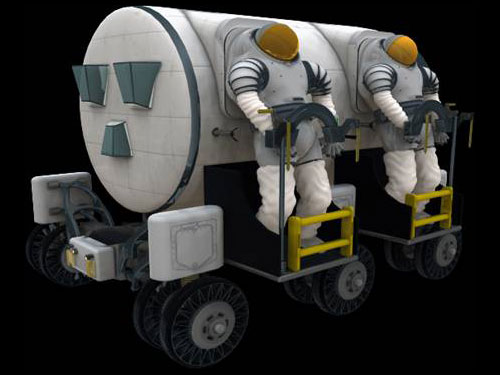 As described by SPACE.com: Astronaut Mike Gernhardt, NASA's lead for extravehicular physiology systems and performance projects, said the agency is now planning to send a pair of pressurized rovers that will allow spaceflyers to explore more of the lunar surface while retaining the relative comfort of a shirt-sleeve environment."They're basically habitats on wheels," Gernhardt said, adding that the new vehicles would be about the same size as the unpressurized rovers driven by astronauts during NASA's Apollo moon landings. "If you can picture this thing, it's kind of a combination between a spacesuit and a sports car." Both rovers would be deployed together, each with a crew of two astronauts. If one rover failed, all four spaceflyers could pile into the remaining vehicle to return to their lunar base, Gernhardt said. Current plans call for a 5,000-pound (2,267-kilogram) pressurized vehicle with seats that fold into beds for longer trips. The two-person rovers would be equipped to handle three-day, seven-day and two-week excursions on the moon with exterior-mounted spacesuits that could be donned by climbing through a shared hatchway, Gernhardt said. It could take just 10 minutes to step into the spacesuits and onto the lunar surface, he added. Short jaunts could cover about 25 miles (40 kilometers) with the two-week trips roving across 596 miles (960 kilometers) across the lunar surface, he added. As to how much the rovers may cost, Gernhardt could only offer an estimate. "I will only say that it will be more than a Ferrari," he said. 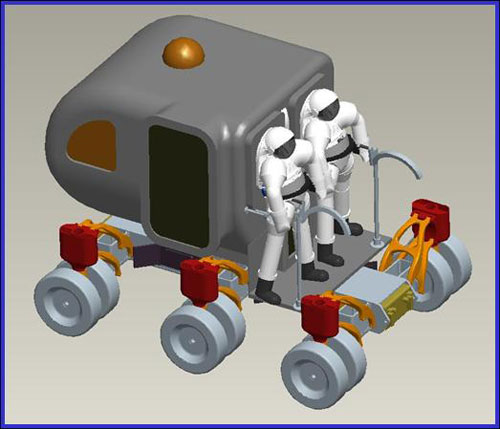 |
GACspaceguy
Member Posts: 2954
From: Guyton, GA
Registered: Jan 2006
|
 posted 09-21-2007 05:29 AM
posted 09-21-2007 05:29 AM
   
This confirms my thoughts that the only way to control the fine lunar "dust" is to keep it outside. I would assume that when the final version is set there would some awning or cover to keep the suits out of direct sunlight exposure during non use. I would assume this would extend the life of the suit outer covering.It will be interesting to see what the plan will be for the repair-ability of the vehicles and the suits. Things like spare fenders and glove coverings have been know to be required! (How about a disposable glove cover?) |
robsouth
Member Posts: 769
From: West Midlands, UK
Registered: Jun 2005
|
 posted 09-21-2007 05:33 AM
posted 09-21-2007 05:33 AM
  
My first thought was Monty Python Sketch! |
cIclops
New Member Posts:
From:
Registered:
|
 posted 09-21-2007 07:37 AM
posted 09-21-2007 07:37 AM
   
Doug Cooke has also talked about a docking port so crew can transfer between FRED and the Outpost ... must be around the other side of the image  Are these variants of the new Constellation Space Suit?
|
Rodina
Member Posts: 836
From: Lafayette, CA
Registered: Oct 2001
|
 posted 09-21-2007 07:43 AM
posted 09-21-2007 07:43 AM
  
Hopefully a roll-cage around the suits, anyway. I don't think we want the helmet to support the weight of a tipped-over rover. |
Robert Pearlman
Editor Posts: 50516
From: Houston, TX
Registered: Nov 1999
|
 posted 09-21-2007 08:44 AM
posted 09-21-2007 08:44 AM
   
quote:
Originally posted by cIclops:
Doug Cooke has also talked about a docking port so crew can transfer between FRED and the Outpost...
There has also been talk about a deployable docking tunnel between the LSAM and FRED, to avoid the need for the crew to go EVA upon landing. |
nasamad
Member Posts: 2185
From: Essex, UK
Registered: Jul 2001
|
 posted 09-21-2007 09:32 AM
posted 09-21-2007 09:32 AM
   
Make better quality suits and give them a rover like the Apollo ones but souped up with a roll cage and more tools.Those ones look bl**dy terrible! Adam |
Robert Pearlman
Editor Posts: 50516
From: Houston, TX
Registered: Nov 1999
|
 posted 09-21-2007 10:15 AM
posted 09-21-2007 10:15 AM
   
quote:
Originally posted by nasamad:
Make better quality suits and give them a rover like the Apollo ones but souped up with a roll cage and more tools.
Adam, I think you're missing the major point of this new design: no matter how much you beef up an Apollo-style rover, unless you pressurize it, you're not going to be able to support excursions across the lunar surface that are multiple weeks in duration. These new rovers aren't planned for 'there and back' drives (though they'll be used for that, too), but rather, leaving the lander behind and going on long road trips, the lunar equivalent of the RV camper... |
nasamad
Member Posts: 2185
From: Essex, UK
Registered: Jul 2001
|
 posted 09-21-2007 11:58 AM
posted 09-21-2007 11:58 AM
   
Ok, Robert, how about a compromise. Lets fit them wit a tow ball and get them to tow a pressurised caravan with them for when they need it. Then they can unhitch it and drive where a real rover should be able to go, like up large hills and into rilles, and go back to their caravan base at the end of the excursion.Adam |
Jay Chladek
Member Posts: 2272
From: Bellevue, NE, USA
Registered: Aug 2007
|
 posted 09-21-2007 08:45 PM
posted 09-21-2007 08:45 PM
   
Oh please, not a caravan on the MOON! Then we would have traffic jams with miles long lines of lunar rovers stacked up behind the things! Tow cars with caravans have to follow speed limits afterall (55 mph). Clarkson, May and Hammond of Top Gear would have a field day with that one!   Seriously though, a small rover would probably get bogged down having to tow something as massive as a pressurized caravan with all the equipment it needs to carry. So much stuff on the thing would become dead weight as a result. So why not combine the resources into something more akin to a recreational vehicle instead of a trailer? For one thing, driving the thing in a shirt sleeve environment rather then having to climb into a hard suit to get into the rover would be less fatiguing. There would also potentially be less wear and tear on suit joints as well if they are stowed when not needed, as opposed to having to keep the things in operation as critical to driving. For these initial surveys, you also don't necessarily want to visit areas that are too inaccessible just yet. Once the big vehicles are up there, then smaller lunar rovers could be sent up and carried onboard for those more focused surveys. You could carry those in either a trailer or strap them to the side. This is a better deal since it is easier for a big vehicle to tow a small trailer, then it is for a small vehicle to tow a large one. And although we are talking 1/6th gravity on the moon, the dust is very abrasive. As such, it can potentially cause excessive wear and tear to an exposed vehicle chassis quite easily. Another advantage of the approach that NASA is going with from what I can see is if they design the access points on the vehicle properly, then simple maintenance of the drive system can be carried out in a pressurized environment, potentially speeding equipment swapouts (such as electric motors) in the process. If one has to do rover maintenance in a hard suit, it may not be too fun a task at all. |
Lunar rock nut
Member Posts: 916
From: Oklahoma city, Oklahoma U.S.A.
Registered: Feb 2007
|
 posted 09-22-2007 09:55 AM
posted 09-22-2007 09:55 AM
   
quote:
Originally posted by Jay Chladek:
the dust is very abrasive. As such, it can potentially cause excessive wear and tear to an exposed vehicle chassis quite easily.
Better pay the extra charge for the undercoating. Terry |
John Charles
Member Posts: 342
From: Houston, Texas, USA
Registered: Jun 2004
|
 posted 09-22-2007 10:16 PM
posted 09-22-2007 10:16 PM
  
quote:
Originally posted by Robert Pearlman citing SPACE.com:
Astronaut Mike Gernhardt, NASA's lead for extravehicular physiology systems and performance projects, said the agency is now planning to send a pair of pressurized rovers that will allow spaceflyers to explore more of the lunar surface while retaining the relative comfort of a shirt-sleeve environment.
I haven't read the Space.com article, but I don't think the decision to send any such devices to the Moon has been made, nor will it be made for several more years. As Project Scientist for the EVA Physiology Systems and Performance project (within the Human Health and Countermeasures Element, of the Human Research Program, itself within the Exploration Systems Mission Directorate), Dr. Gernhardt is deeply involved in understanding the physiological consequences of lunar EVAs. He and his colleagues have developed novel ideas that may be incorporated in the new EVA suits to increase astronauts' safety and efficiency and decrease their discomfort and injury potential. He has also proposed various rover-based concepts to further enable safe and efficient lunar exploration.But, at a time when the very architecture of the Orion crew module is under review, and there are concerns about the ability of the new launch vehicles to lift their payloads, I think it is premature to say that NASA is now "planning" to do anything so concrete as to develop and launch any of the rovers illustrated in that article. These are concepts, intended for further ananlysis. As a calibration, note that the most optimistic scenario for sending NASA astronauts back to the Moon shows a launch date no earlier that 2018 (11 years from now!) and more likely later, and recall how significantly NASA's Apollo plans evolved over its 7-year lifetime before Apollo 11, and especially in the last three years before Apollo 11. Project Orion will certainly not be any different. ------------------
John Charles
Houston, Texas |
Robert Pearlman
Editor Posts: 50516
From: Houston, TX
Registered: Nov 1999
|
 posted 02-01-2008 09:56 AM
posted 02-01-2008 09:56 AM
   
ABC News: NASA Rolls Out Lunar Hot Rod When this hot rod rolls out on the street, traffic stops and people stare.People aren't quite sure what to make of the bright-white vehicle with gold rims and gold trim that is a cross between an off-road vehicle and someone's fantasy hot rod. This vehicle is dubbed the Chariot by the design team at the Johnson Space Center. This team was given one year to design and build this ultimate concept lunar rover. Also see NASA's Chariot website for photos and videos. |
NavySpaceFan
Member Posts: 663
From: Norfolk, VA
Registered: May 2007
|
 posted 02-01-2008 04:41 PM
posted 02-01-2008 04:41 PM
   
Wonder if they had this in mind when they named it. |
Robert Pearlman
Editor Posts: 50516
From: Houston, TX
Registered: Nov 1999
|
 posted 02-27-2008 01:26 PM
posted 02-27-2008 01:26 PM
   
NASA release
NASA'S Newest Concept Vehicle Takes Off-Roading Out of This World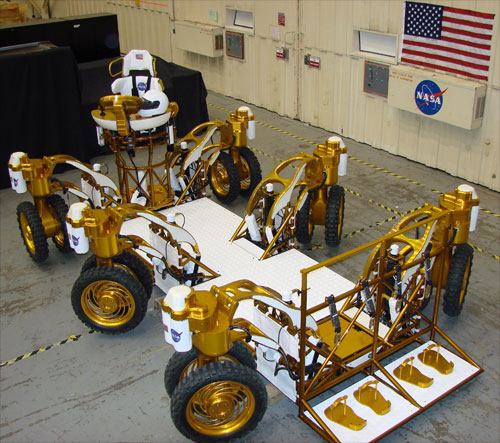
In a car commercial, it would sound odd: active suspension, six-wheel drive with independent steering for each wheel, no doors, no windows, no seats and the only color available is gold.But NASA's latest concept vehicle is meant to go way off-road, as in 240,000 miles from the nearest pavement, and drive on the moon. NASA is working to send astronauts to the moon by 2020 to set up a lunar outpost, where they will do scientific research and prepare for journeys to more distant destinations. Built at NASA's Johnson Space Center, Houston, the new design is one concept for a future lunar truck. The vehicle provides an idea of what the transportation possibilities may be when astronauts start exploring the moon. Other than a few basic requirements, the primary instruction given to the designers was to throw away assumptions made on NASA's previous rovers and come up with new ideas. "To be honest with you, it was scary when we started," said Lucien Junkin, a Johnson robotics engineer and the design lead for the prototype rover. "They tasked us last October to build the next generation rover and challenge the conventional wisdom. The idea is that, in the future, NASA can put this side-by-side with alternate designs and start to pick their features." One of the first standards to go was the traditional expectation that a vehicle should have four wheels. Mars rovers Spirit and Opportunity, still cruising around the Red Planet, have already proved the value of a couple of extra wheels. When one of the six wheels became inoperable, the rovers had no problem rolling on using the remaining five. With the number of wheels decided, the next question was how those wheels should turn. On a car, the front wheels turn a few inches in either direction, and both wheels point in the same direction. On this rover, all six wheels can pivot individually in any direction, regardless of where any other wheel points. To parallel park, a driver could pull up next to the parking place, turn all the wheels to the right and slide right in. Of course, astronauts will not have trouble finding a parking space on the moon. But the feature, called crab steering, has advantages for a vehicle designed to drive into the craters of the moon. If a slope is too steep to drive down safely, the vehicle could drive sideways instead - no backing up or three-point turns required. The all-wheels, all-ways steering also could come in handy when unloading and docking payloads or plugging into a habitat for recharging. Introducing crab steering drove the concept in several other ways. If the rover's wheels turn to drive in a different direction, the driver needs to be able to do the same. The driver stands at the steering mechanism because sitting in a spacesuit is not comfortable or practical. The astronaut's perch - steering mechanism, driver and all - can pivot 360 degrees. "The Apollo astronauts couldn't back up at all because they couldn't see where they were going in reverse," said Rob Ambrose, assistant chief of the Automation, Robotics and Simulation Division at Johnson. "If you have a payload on the back or are plugging into something, it could be really important to keep your eyes directly on it." The vehicle also can be the ultimate low-rider. It can lower its belly to the ground, making it easier for astronauts in spacesuits to climb on and off. Individual wheels or sections can be raised and lowered to keep the vehicle level when driving on uneven ground. Some, all or none of these features may be selected for the design of a rover that eventually goes to the moon. NASA's lunar architects currently envision pressurized rovers that would travel in pairs, with two astronauts in each rover. The new prototype vehicle is meant to provide ideas as those future designs are developed. "This rover concept changed the whole paradigm," said Diane Hope, program element manager for NASA's Exploration Technology Development Program at NASA's Langley Research Center in Hampton, Va., which sponsored the vehicle's development. "It's not something I would have expected. It provides an alternative approach." |
Robert Pearlman
Editor Posts: 50516
From: Houston, TX
Registered: Nov 1999
|
 posted 03-28-2008 09:09 PM
posted 03-28-2008 09:09 PM
   
A couple of recent articles about the Chariot: - Not a Mercury or Saturn, but It Goes Way Off Road (New York Times)
It turns on a dime and parallel-parks like a dream.On the downside, it�s a little pricey (at $2 million or so) and its top speed is a pokey 15 miles an hour. Still, there�s a lot to like about the concept car taking shape here at the Johnson Space Center. - Lunar Chariot prepares to tear up some moon dust (New Scientist)
This isn't your father's idea of a space rover. NASA's Chariot is the first prototype in a new line of lunar vehicles that could someday bulldoze roads, dig trenches, and drill for minerals on the moon. And it is already proving as nimble as it is powerful in earthbound testing.
|
Lou Chinal
Member Posts: 1387
From: Staten Island, NY
Registered: Jun 2007
|
 posted 04-11-2008 06:40 PM
posted 04-11-2008 06:40 PM
   
I remember that the limiting factor for Apollo was how far the astronauts could walk back if the rover broke down (6 miles I think). Has any thought been given to bringing some bicycles along? I don't even know if it would be possible to use a bicycle on the moon. I never asked any moonwalkers I met. Just something that popped into my head reading this post.-Lou |
Robert Pearlman
Editor Posts: 50516
From: Houston, TX
Registered: Nov 1999
|
 posted 04-11-2008 06:48 PM
posted 04-11-2008 06:48 PM
   
quote:
Originally posted by Lou Chinal:
Has any thought been given to bringing some bicycles along?
TIME Magazine, January 8, 1979: Moon Bike It is the future, and American astronauts have again landed on the moon. Emerging from their spacecraft, they perform such familiar chores as setting up a TV camera, placing various scientific instruments around their landing site, and collecting rocks and samples of the dusty lunar soil. Then they return to the ship to prepare for more far-ranging exploration. When the spacecraft's big hatch reopens, the astronauts scoot out, pedaling away as if they were on bicycles.A bike on the moon? Yes, says M.I.T. Mechanical Engineer David Gordon Wilson, who insists human-powered transportation, as he calls it, is really the only way to go on a moon mission. Adds Wilson: "Such a vehicle offers lunar explorers convenience, reliability, independence of energy supplies and beneficial physiological effects." |
Robert Pearlman
Editor Posts: 50516
From: Houston, TX
Registered: Nov 1999
|
 posted 09-09-2008 12:13 AM
posted 09-09-2008 12:13 AM
   
On Monday, NASA provided the media a chance to view the Chariot rover and its pressurized cab prototype inside Building 9 at Johnson Space Center. 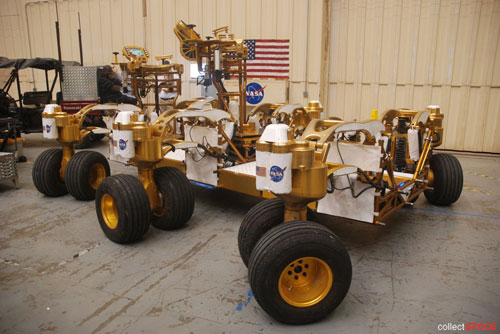
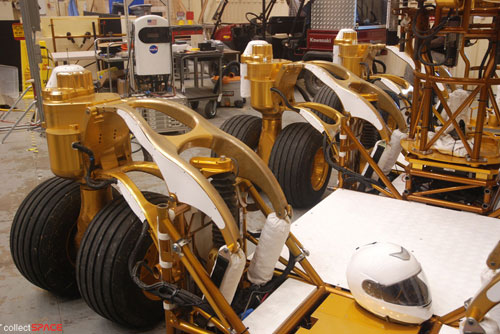
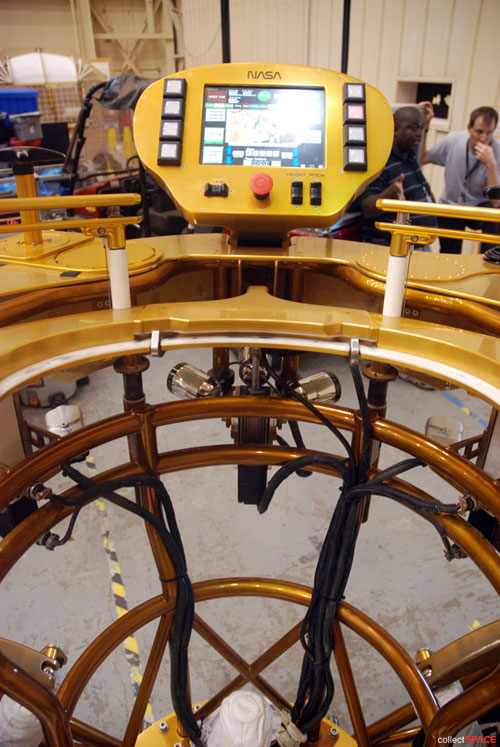
Standing at the on-board controls... 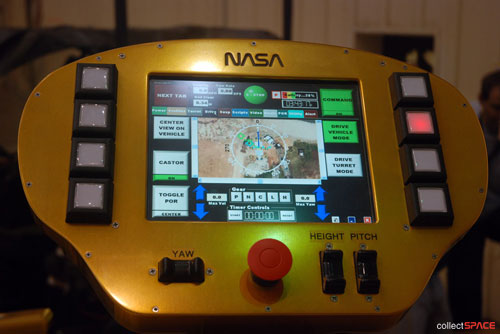 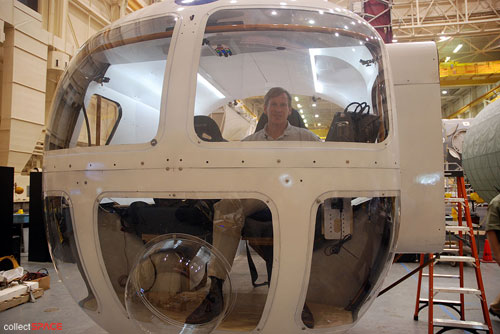
Astronaut Mike Gernhardt sits inside the mock-up of the small pressurized cab that attaches atop the Chariot. Inside, astronauts on the Moon could operate in a shirt-sleeve environment and not just drive, but live within the cab for several days. The cab is outfitted with a galley, two bunk beds, a toilet (with privacy curtain), storage bins and even cup holders... |
John Charles
Member Posts: 342
From: Houston, Texas, USA
Registered: Jun 2004
|
 posted 09-09-2008 05:29 AM
posted 09-09-2008 05:29 AM
  
What's the deal with the NASA "worm" on the instrument panel? Is the console a left-over from an earlier concept, I wonder?------------------
John Charles
Houston, Texas |
Robert Pearlman
Editor Posts: 50516
From: Houston, TX
Registered: Nov 1999
|
 posted 09-09-2008 10:25 AM
posted 09-09-2008 10:25 AM
   
quote:
Originally posted by John Charles:
Is the console a left-over from an earlier concept, I wonder?
I asked this morning: the console is new, it was built for Chariot. They just decided to put a worm on it (apparently there were other worms on the vehicle when it first rolled out, but they have since been removed or replaced with the meatball). |
Space Possum
New Member Posts:
From:
Registered:
|
 posted 09-09-2008 12:24 PM
posted 09-09-2008 12:24 PM
   
quote:
Originally posted by Robert Pearlman:
The cab is outfitted with a galley, two bunk beds, a toilet (with privacy curtain), storage bins and even cup holders...
Cup holders?!! Now THESE are mission critical items for ANY respectable R.V.! I like it!Now I want to know if it will have a flat screen TV and can we watch the NASCAR races on it? Hmmm... Maybe some of the custom RV builders in my area should put in a bid.  |
Mr Meek
Member Posts: 353
From: Chattanooga, TN
Registered: Dec 2007
|
 posted 09-09-2008 12:52 PM
posted 09-09-2008 12:52 PM
  
That's one small step for (a) van, one giant leap for vankind. |
Hart Sastrowardoyo
Member Posts: 3466
From: Toms River, NJ
Registered: Aug 2000
|
 posted 09-09-2008 01:15 PM
posted 09-09-2008 01:15 PM
   
The front of the cab where the astro is sitting reminds me of the early models of the LEM, with the big windows, right down to the round entry port. |
Robert Pearlman
Editor Posts: 50516
From: Houston, TX
Registered: Nov 1999
|
 posted 09-09-2008 01:36 PM
posted 09-09-2008 01:36 PM
   
quote:
Originally posted by Hart Sastrowardoyo:
...right down to the round entry port.
Ah, I forgot to mention that port and it's really neat! That bubble is meant as a portal through which an astronaut, lying down in the cab, could look out and down at the surface for a careful and close-up look. I guess you could call it a "heads-out" display. |
328KF
Member Posts: 1388
From:
Registered: Apr 2008
|
 posted 09-09-2008 04:33 PM
posted 09-09-2008 04:33 PM
   
That's alot of plexiglass for such a harsh environment. That nasty lunar dust will make that bubble pretty useless after a few weeks on the surface.They'll have to take some polish along to keep those windows looking good! |
LCDR Scott Schneeweis
New Member Posts:
From:
Registered:
|
 posted 09-09-2008 06:13 PM
posted 09-09-2008 06:13 PM
   
Its a neat feature but appears susceptible to impact damage------------------
Scott Schneeweis
http://www.SPACEAHOLIC.com/ |
Robert Pearlman
Editor Posts: 50516
From: Houston, TX
Registered: Nov 1999
|
 posted 09-09-2008 07:44 PM
posted 09-09-2008 07:44 PM
   
quote:
Originally posted by LCDR Scott Schneeweis:
Its a neat feature but appears susceptible to impact damage
Maybe, but it will be well off the ground, sitting atop the lunar truck's chassis. You can see the Chariot in motion (and maybe even spot yours truly) in this local ABC News video: The latest in moon rides. (Note: Obviously, 2010 was in error; the reporter intended to say 2020.) |
Robert Pearlman
Editor Posts: 50516
From: Houston, TX
Registered: Nov 1999
|
 posted 09-10-2008 02:16 PM
posted 09-10-2008 02:16 PM
   
A few other notes: - Goodyear is currently working on a tire for the Chariot based on the Apollo LRV stainless steel mesh tire.
- Separately, Michelin is developing a tire for the rover, too.
- The wheel system was inspired by the Mars rovers. Like Spirit and Opportunity, Chariot can drive on just five out of its six wheels, regardless of which wheel fails. Unlike the rovers, Chariot can lift its bad wheel (or any wheel) completely off the ground as to not hinder movement.
|
Robert Pearlman
Editor Posts: 50516
From: Houston, TX
Registered: Nov 1999
|
 posted 12-04-2008 02:30 PM
posted 12-04-2008 02:30 PM
   
quote:
Originally posted by Robert Pearlman:
Goodyear is currently working on a tire for the Chariot based on the Apollo LRV stainless steel mesh tire.
See: Goodyear developing lunar rover wheel quote:
Separately, Michelin is developing a tire for the rover, too.
See: Michelin developing lunar rover wheel |























